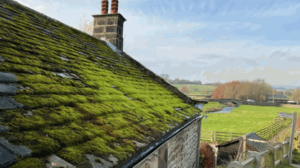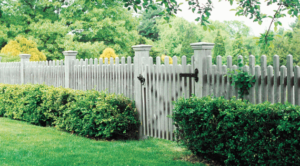Are you looking to give your deck a fresh new look? One of the key steps in deck maintenance is washing it regularly. But, what pressure should you use to wash your deck? Choosing the right pressure is crucial to prevent damage to the wood and surrounding areas, while also ensuring efficient cleaning.
In this article, we will explore the importance of washing your deck, the risks of using too much pressure, the benefits of using the right pressure, and how to properly wash your deck to keep it looking its best. Let’s dive in!
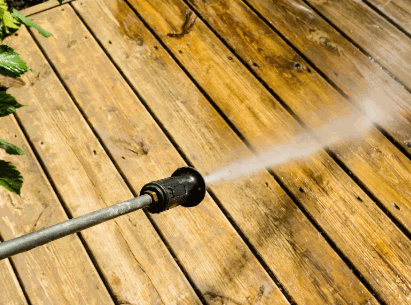
Why Is It Important To Wash Your Deck?
Maintaining a clean deck is crucial for preserving its longevity and appearance. Regular deck cleaning helps prevent mold, mildew, and algae growth, ensuring the wood’s integrity and beauty.
By using appropriate cleaning solutions, you can effectively remove dirt, grime, and other debris that accumulate over time and cause potential damage to the deck’s surface. These solutions are specially formulated to break down built-up residues without harming the wood, thus prolonging the life of your deck.
Regular maintenance prevents discoloration and fading, keeping the deck looking vibrant and inviting for outdoor gatherings and relaxation.
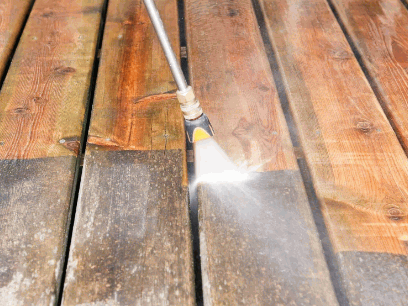
What Pressure Should You Use To Wash Your Deck?
Determining the correct water pressure for deck washing is essential to avoid damage whilst effectively cleaning the deck surface. Using the right pressure level ensures thorough cleaning without compromising the wood’s integrity.
Excessive water pressure can lead to gouging or splintering of the wood, causing irreversible damage. It is crucial to choose a pressure washer that allows for adjustable settings, enabling control over the force applied during cleaning.
Electric pressure washers are often recommended for more delicate deck materials like cedar or redwood, as they offer better pressure control compared to gas-powered counterparts. By regulating the pressure, one can ensure that the cleaning process is both efficient and safe for the deck.
What Type Of Pressure Washer Should You Use?
Choosing the right pressure washer is crucial for effective deck cleaning. It’s essential to consider the pressure washer type, whether high pressure for tough stains or a gentle low-pressure wash for delicate surfaces.
- High-pressure pressure washers, often referred to as power washers, are ideal for deep cleaning stubborn dirt, grime, and mold from decks. These models exert a significant amount of force, making them suitable for tackling tough stains and large surface areas efficiently.
- On the other hand, low-pressure washers, such as soft washers, are better suited for more fragile surfaces that may be damaged by high water pressure. The key component that enables these varying pressure levels is the power washer nozzle, which allows users to adjust the water pressure output to suit specific cleaning needs.
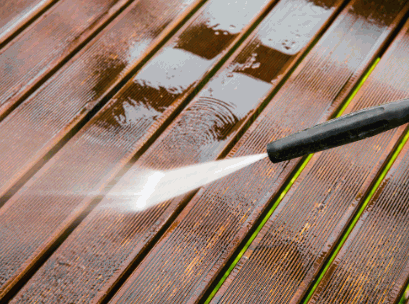
How To Choose The Right Pressure For Your Deck?
Selecting the correct pressure for your deck requires understanding the material and condition of the surface. Proper surface preparation and adherence to pressure washing tips ensure effective cleaning without causing damage.
Different types of deck materials like wood, composite, or concrete may require varying pressure levels. For instance, softer woods like cedar or pine are more susceptible to damage, so a lower-pressure setting is recommended. On the other hand, composite and concrete decks can handle higher pressures.
Before starting, always test a small inconspicuous area to determine the appropriate pressure. Ensure the deck is free of any dirt, debris, and loose paint before beginning the pressure washing process to prevent any potential harm to the surface.
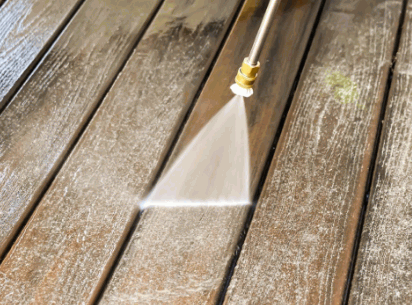
What Are The Risks Of Using Too Much Pressure?
Excessive pressure during deck cleaning can lead to various risks, including damage to the wood structure, harm to the surrounding environment, and increased risk of personal injury.
Using too much pressure while cleaning the deck can result in splintering, warping, or even cracking of the wood, diminishing its aesthetic appeal and structural integrity. The forceful spray can dislodge paint or stain, causing uneven discoloration or stripping away protective coatings. Beyond the deck itself, high-pressure washing can harm nearby plants, soil, and even cladding or windows if not controlled properly. The powerful stream can create slippery surfaces, increasing the likelihood of slips and falls during and after cleaning.
Damage To The Wood
Applying excessive pressure whilst cleaning the deck can cause significant damage, leading to issues such as stripped deck stains, compromised finishes, and potential harm to the wood structure.
This excessive pressure can penetrate deep into the wood fibers, causing them to splinter and crack, which can weaken the overall structural integrity of the deck.
In addition, forceful water streams can also dislodge protective coatings, leaving the wood vulnerable to moisture infiltration and subsequent decay.
To counteract these effects, it is crucial to implement proper algae removal techniques to prevent the growth of organisms that can exacerbate wood deterioration. Utilizing gentle cleaning methods and applying suitable wood preservation treatments can help maintain the deck’s longevity and aesthetic appeal.
Damage To The Surrounding Area
Using too much pressure during deck cleaning not only risks damaging the deck but also poses a threat to the surrounding environment. It can lead to excessive water runoff, contamination from harsh cleaners, and ecosystem disruption.
This highlights the critical need for adopting eco-friendly cleaning solutions and responsible techniques to minimize the negative impact on the environment. By using biodegradable cleaners and appropriate deck cleaning products, cleaning processes can be conducted in a more sustainable way. Eco-friendly cleaners break down naturally, reducing the risk of harming aquatic life and soil quality. Opting for responsible cleaning techniques helps in conserving water resources while maintaining the beauty of outdoor spaces without compromising the ecosystem.
Risk Of Injury
Operating pressure washing equipment at high levels without proper training or expertise can increase the risk of personal injury. It is advisable to seek the assistance of professional deck cleaners or pressure washing services to mitigate potential harm.
High-pressure cleaning involves powerful equipment that can cause serious injuries if not handled with care. Novice users may underestimate the force of the water stream, leading to accidents or damage to property.
Professional deck cleaners have the necessary skills and knowledge to operate the equipment safely. They can also assess the specific needs of your deck and choose the appropriate cleaning methods. By hiring experts, you not only ensure a thorough and effective cleaning process but also safeguard your well-being and property from harm.
What Are The Benefits Of Using The Right Pressure?
Utilizing the correct pressure for deck washing offers several advantages, including efficient cleaning, enhanced deck care, adherence to a structured maintenance schedule, and the potential for deck restoration.
By using the appropriate pressure level during deck cleaning, homeowners can ensure that dirt, grime, and stains are effectively removed without causing damage to the wood. This not only leads to a cleaner deck but also helps in maintaining its quality over time.
Consistent use of the right pressure settings promotes regular deck maintenance, enabling homeowners to stick to their maintenance routine. The revitalization techniques applied during cleaning can breathe new life into the deck, making it look fresh and appealing once again.
Dive into details: How To Pressure Wash Driveway
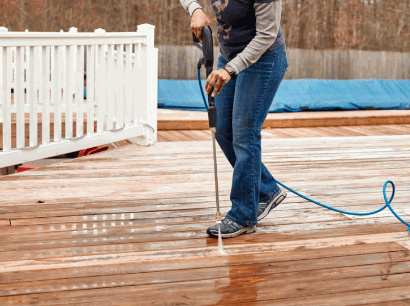
Efficient Cleaning
Optimal pressure application leads to efficient cleaning, reducing the need for extensive manual scrubbing and brushing. It also facilitates the application of deck sealers and enhances the effectiveness of power-washing businesses.
The use of proper pressure levels in power washing not only saves time and effort but also ensures a thorough and effective cleaning. By applying the right pressure, you can remove tough stains and grime without causing damage to the surfaces being cleaned. This precision in pressure application is crucial for deck sealing as it ensures the sealant penetrates evenly for long-lasting protection. Businesses in the power washing industry can significantly benefit from utilizing the correct pressure, as it leads to better customer satisfaction and repeat business due to quality results.
Prevents Damage To The Deck
Applying the correct pressure safeguards the deck from damage, reducing the need for extensive refurbishment, refreshing the deck’s appearance, and facilitating the deck staining process.
By exerting the appropriate pressure, the deck’s surface is effectively cleansed without causing any structural harm. This maintenance technique not only enhances the overall look of the deck but also helps in preparing the surface for subsequent staining.
When pressure washing is done with precision, it enables the removal of ingrained dirt, mold, and grime, ensuring that the deck is thoroughly cleaned and primed. This, in turn, contributes to preserving the deck’s integrity and prolonging its lifespan, making it a crucial step in deck maintenance routines.
Saves Time And Energy
Using the right pressure not only preserves the deck but also saves time and energy during the cleaning process. It expedites deck renovation, revamping efforts, and overall enhancement of the deck’s aesthetic appeal.
This time-saving approach allows individuals to efficiently tackle deck cleaning tasks without sacrificing the quality of the results. By utilizing the correct pressure settings, you can significantly reduce the time spent on scrubbing and ensure a thorough cleaning. As a result, the deck’s appearance is swiftly rejuvenated, making it a more inviting and visually appealing space for relaxation and entertaining guests. Power washer nozzles play a crucial role in this efficiency, providing options to adjust the pressure levels for different cleaning needs, further optimizing the cleaning process.
How To Properly Wash Your Deck?
Executing a thorough deck cleaning process involves proper preparation, understanding deck materials, selecting suitable cleaning products, and ensuring meticulous surface preparation for optimal results.
- When embarking on the task of washing your deck, it’s crucial to start by clearing the deck of any furniture, plants, or debris. Sweep the surface thoroughly to remove loose dirt and leaves.
- For wooden decks, be mindful of the type of wood as different woods may require specific cleaning methods. Consider factors such as age, condition, and previous treatments of the deck before choosing a cleaning product. Opt for environmentally friendly cleaners whenever possible to minimize environmental impact.
- Prior to applying any cleaning solutions, ensure that the deck is completely dry to allow the products to work effectively.
Prepare The Deck
Preparing the deck before cleaning is essential for maintaining its longevity and appearance. Implementing a deck care regime, adhering to a maintenance schedule, and considering refurbishment needs are crucial steps.
Regular deck care practices can prevent issues like mold, mildew, and wood rot. By inspecting the deck for damage and applying protective sealants, homeowners can extend the life of their outdoor space.
When refurbishment is needed, proper preparation involves clearing the deck of furniture and debris, power washing to remove grime, and sanding for a smooth surface. Choosing the right cleaning products and tools ensures the effective removal of stains and dirt, making the deck ready for staining or painting.
Choose The Right Pressure And Nozzle
Selecting the appropriate pressure level and nozzle type is crucial for achieving optimum cleaning results. Understanding deck pressure washing techniques and considering power washer nozzles facilitate effective deck staining.
By matching the pressure level to the task at hand, you can prevent damage to your deck surface while still achieving a thorough clean. For instance, using a lower-pressure setting with a wide-angle nozzle for general cleaning can help prevent etching on softer wood types. On the other hand, when preparing your deck for staining, a higher pressure with a narrower nozzle can effectively strip away old finishes and open up the wood pores for better absorption of the stain. Making these adjustments not only enhances the cleaning process but also sets the stage for a successful and long-lasting deck restoration project.

Start From The Top And Work Your Way Down
Commencing the cleaning process from the top and progressing downwards ensures thorough deck coverage and effective sealing. It also supports the application of deck finishes and enhances the prospects for power washing business growth.
This systematic approach not only guarantees a more uniform and comprehensive cleaning outcome but also facilitates the proper application of sealants and finishes to protect and enhance the deck’s appearance.
By starting from the top, dirt, grime, and contaminants are efficiently washed away, allowing for a more efficient process. This methodical method not only improves the aesthetics of the deck but also creates a strong foundation for power-washing businesses to expand their services and attract more clients seeking professional deck maintenance.
Rinse Thoroughly
Thorough rinsing post-cleaning is essential to complete the process and prepare the deck for staining or treatment. It ensures effective deck enhancement and preserves the integrity of the wood deck.
Proper rinsing plays a crucial role in ensuring that any remaining cleaning solution or debris is completely removed from the surface of the deck. This step not only enhances the visual appeal of the deck but also acts as a primer for the subsequent application of stains or treatments. By thoroughly rinsing the deck, you create a clean and receptive surface that allows the stain or treatment to penetrate the wood evenly, resulting in a more uniform finish. Adequate rinsing helps maintain the structural integrity of the wood by preventing any residual cleaning agents from causing long-term damage.


